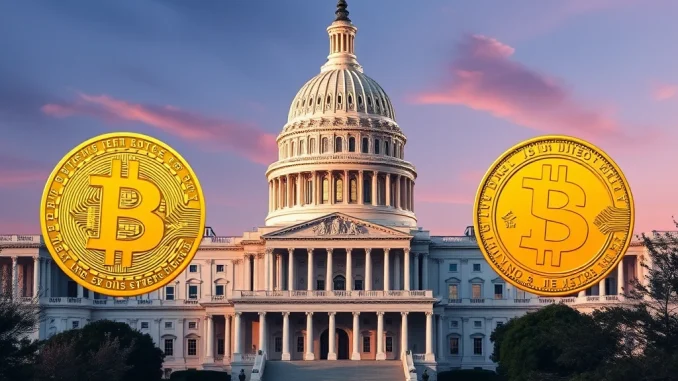
Exciting news for the crypto world! As the digital asset landscape continues its explosive growth, lawmakers are stepping up to provide much-needed regulatory clarity. The U.S. House of Representatives has just dropped its highly anticipated version of a stablecoin bill, signaling a significant leap forward in crypto legislation. This move underscores the increasing momentum to establish a clear framework for digital currencies in the United States. Let’s dive into what this landmark bill means for the future of crypto.
What’s the Buzz Around the Stablecoin Bill?
Spearheaded by Reps. Bryan Steil and French Hill, the House’s stablecoin bill is officially in the arena. This legislation is designed to bring stablecoin regulation into sharper focus, specifically targeting digital tokens that are pegged to the U.S. dollar. It’s not operating in a vacuum either; this House bill is intentionally crafted to align closely with its bipartisan counterpart in the Senate. In fact, the Senate’s version has already cleared a crucial committee hurdle, indicating strong bipartisan support for regulating these digital assets.
This House proposal is known as the STABLE Act. The acronym itself speaks volumes about the intended outcome: to bring stability to the digital currency ecosystem. But this isn’t just about one bill. The STABLE Act is part of a much larger, concerted effort to finalize comprehensive crypto legislation by August. The clock is ticking, and Washington seems determined to get the rules of the road laid out for the burgeoning crypto industry.
Why is Crypto Legislation Gaining Momentum Now?
The push for crypto legislation isn’t happening in isolation. Several key developments are converging to create this sense of urgency and forward motion:
- Senate Progress: The Senate’s bipartisan bill advancing through committee has paved the way, demonstrating that there’s real political will to address crypto regulation in a collaborative manner.
- Broader Regulatory Push: The August target for finalizing crypto legislation suggests a comprehensive approach is underway, aiming to cover various aspects of the digital asset space, not just stablecoins.
- Securities Clarity Act Reintroduction: Rep. Tom Emmer’s reintroduction of the Securities Clarity Act is another crucial piece of the puzzle. This act seeks to define precisely how digital assets should be categorized under existing securities laws. Clear definitions are essential for businesses and investors to operate with confidence and compliance.
- Senate’s DeFi Stance: Adding to the regulatory buzz, the Senate is gearing up for a second vote on a resolution to overturn the IRS’s DeFi broker rule. This is significant, particularly as former President Trump is expected to sign it, signaling potential bipartisan agreement on certain crypto-related issues. According to CoinDesk, this vote highlights the ongoing debate and refinement of tax rules within the decentralized finance (DeFi) sector.
How Will This Stablecoin Regulation Impact the Crypto Market?
The introduction of the House stablecoin bill and the broader push for stablecoin regulation carry significant implications for the cryptocurrency market. Let’s consider both the potential benefits and challenges:
Potential Benefits:
- Increased Investor Confidence: Clear regulatory frameworks can instill greater confidence in investors, both institutional and retail. Knowing the rules of engagement reduces uncertainty and can attract more capital into the crypto space.
- Market Stability: As the name suggests, stablecoin regulation aims to enhance the stability of these dollar-pegged tokens. This is crucial as stablecoins play a vital role in crypto trading and as a bridge between traditional finance and the digital asset world.
- Mainstream Adoption: Regulatory clarity is often seen as a prerequisite for wider mainstream adoption of cryptocurrencies. Businesses and individuals are more likely to engage with digital assets when they operate within a well-defined legal and compliance environment.
- Innovation and Growth: While regulation is sometimes perceived as stifling innovation, well-designed rules can actually foster sustainable growth by creating a level playing field and reducing risks associated with illicit activities.
Potential Challenges:
- Compliance Burdens: New regulations inevitably bring compliance requirements. Crypto companies will need to adapt to these new rules, which may involve costs and operational adjustments. The complexity of these regulations will be a key factor.
- Innovation Hurdles: If regulations are too restrictive or poorly designed, they could inadvertently stifle innovation within the crypto sector. Finding the right balance between consumer protection and fostering innovation is crucial.
- Global Harmonization: Cryptocurrencies are global by nature. For regulations to be truly effective, international cooperation and harmonization will be essential. Divergent rules across jurisdictions could create arbitrage opportunities or compliance complexities.
What’s Next for Crypto Legislation and Digital Assets?
The release of the House stablecoin bill is a major step, but it’s just one piece of a larger puzzle. The momentum behind crypto legislation is undeniable, with actions happening across different fronts:
- House and Senate Bills: The parallel efforts in the House and Senate to regulate stablecoins indicate a unified direction. The alignment between these bills will be critical for swift progress.
- Securities Clarity Act: Rep. Emmer’s bill aims to resolve definitional ambiguities around digital assets and securities laws, which is fundamental for establishing legal certainty.
- IRS DeFi Rule Vote: The Senate’s upcoming vote on the IRS DeFi rule highlights the ongoing dialogue about tax implications in the decentralized finance space.
- August Deadline: The self-imposed August deadline for finalizing crypto legislation suggests a concerted push to bring these regulatory efforts to fruition in the near term.
For anyone involved or interested in cryptocurrencies and digital assets, staying informed about these legislative developments is now more crucial than ever. The regulatory landscape is evolving rapidly, and these changes will shape the future trajectory of the crypto industry in the U.S. and potentially globally.
Conclusion: A Transformative Moment for Crypto Regulation
The unveiling of the House stablecoin bill marks a transformative moment in the ongoing saga of crypto legislation in the United States. Coupled with the Senate’s progress, Rep. Emmer’s Securities Clarity Act, and the discussions around DeFi taxation, it’s clear that Washington is taking digital asset regulation seriously. While the specifics of the final regulations are still to be determined, the direction is unmistakable: crypto is moving towards a regulated future. This could usher in a new era of stability, legitimacy, and wider adoption for cryptocurrencies, paving the way for digital assets to become an even more integral part of the global financial system. Keep watching this space – the crypto regulatory journey is just beginning to accelerate!



